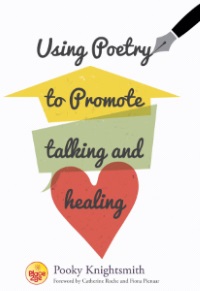It can be a struggle for young people to acknowledge overwhelming emotions and how to express them. In Using Poetry to Promote Talking and Healing, Dr. Pooky Knightsmith outlines how we can help students to express their emotions clearly and safely.

 In Using Poetry to Promote Talking and Healing, Dr. Pooky Knightsmith suggests many valuable alternatives to making the implicit, explicit.
In Using Poetry to Promote Talking and Healing, Dr. Pooky Knightsmith suggests many valuable alternatives to making the implicit, explicit.
The book provides schools and SENCos with guidance as to how different methods of using poetry can open up discussions, whilst it successfully demystifies a comprehensive set of topics, such as insecurity, anxiety, self-esteem, interaction with others, loss, amongst others.
The topics are easily relatable and are especially important in the current output-driven-climate for children and young people going through so many changes in life.
The user-friendly ideas proposed in this book will benefit any professional eager to introduce non-directive and creative approaches to managing mental health.
The ideas include techniques that enable students to explore their feelings on paper when saying them out loud is too difficult, ways of promoting reflection, and help explore future actions.
The book also explores the possibilities and ways that students can write their own poetry, using useful prompts to support writing. On doing so, the feeling becomes visual, almost palpable, as if the paper becomes alive with the feeling itself.
This is especially helpful to children and adolescents still shaping their thinking and judgment as they develop into the adults of tomorrow. It then becomes clearer to see and acknowledge issues and challenges and to subsequently have control over it and, eventually, have the capacity to change it.
This and other artistic ideas and tools proposed by Dr. Knighsmith can also enable active listening competences and the ability to understand the other person’s position and circumstance, thereby promoting social skills and an openness of discussion.
In this book, poetry has got the spotlight, although the author also supports other creative self-expression ideas, such as collage, drawing and painting, storytelling, debating, writing and reading. This will help the member of staff and the student to find the best individual strategy to clarity of thinking and feeling.
One of the ideas that particularly caught my attention was the Dear me letter. It involves writing a letter giving advice to a younger self. Whilst doing this exercise, for instance with a student who is exhibiting challenging behaviour, the letter can answer the questions:
Furthermore, the answers to these questions feel a step closer to conscious choices, supported decisions and empowerment.
Reading this book is an experience similar to changing gears, the necessary trigger to self-knowledge and motivation towards change.
The book offers a complete resource for schools and therapists in exploring important mental health issues and would also provide a useful starting point for the PSHE and Life Education curriculum.
This heart-warming book also offers flexible guidelines to initiate a process of self knowledge through poetry or other creative means.
The many strategies proposed by the author invite the reader to naturally be the writer of their own life story.
Before you know it, both the student being supported and you will have your pages full with ink!
Using Poetry to Promote Talking and Healing is available to purchase from www.jkp.com.
'More than third of teenage girls in England suffer depression and anxiety.' (Open Door, September 2016).
Our Safeguarding Teenagers: Supporting Mental Health & Protecting Young People Online conference will be the perfect opportunity to:
Register now to secure your place!